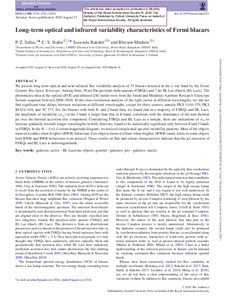Long-term optical and infrared variability characteristics of Fermi blazars
P. Z. Safna; Blesson Mathew; Suvendu Rakshit; C. S. Stalin
Long-term optical and infrared variability characteristics of Fermi blazars
P. Z. Safna
Blesson Mathew
Suvendu Rakshit
C. S. Stalin
OXFORD UNIV PRESS
Julkaisun pysyvä osoite on:
https://urn.fi/URN:NBN:fi-fe2021042825758
https://urn.fi/URN:NBN:fi-fe2021042825758
Tiivistelmä
We present long-term optical and near-infrared flux variability analysis of 37 blazars detected in the gamma-ray band by the Fermi Gamma-Ray Space Telescope. Among them, 30 are flat spectrum radio quasars (FSRQs) and 7 are BL Lac objects (BL Lacs). The photometric data in the optical (BVR) and infrared (JK) bands were from the Small and Moderate Aperture Research Telescope System acquired between 2008-2018. From cross-correlation analysis of the light curves at different wavelengths, we did not find significant time delays between variations at different wavelengths, except for three sources, namely PKS 1144-379, PKS B1424-418, and 3C 273. For the blazars with both B- and J-band data, we found that in a majority of FSRQs and BL Lacs, the amplitude of variability (sigma(m)) in the J band is larger than that in B band, consistent with the dominance of the non-thermal jet over the thermal accretion disc component. Considering FSRQs and BL Lacs as a sample, there are indications of sigma(m) to increase gradually towards longer wavelengths in both, however, found to be statistically significant only between B and J bands in FSRQs. In the B - J v/s J-colour magnitude diagram, we noticed complicated spectral variability patterns. Most of the objects showed a redder when brighter (RWB) behaviour. Few objects showed a bluer when brighter (BWB) trend, while in some objects both BWB and RWB behaviours were noticed. These results on flux and colour characteristics indicate that the jet emission of FSRQs and BL Lacs is indistinguishable.
Kokoelmat
- Rinnakkaistallenteet [19207]
